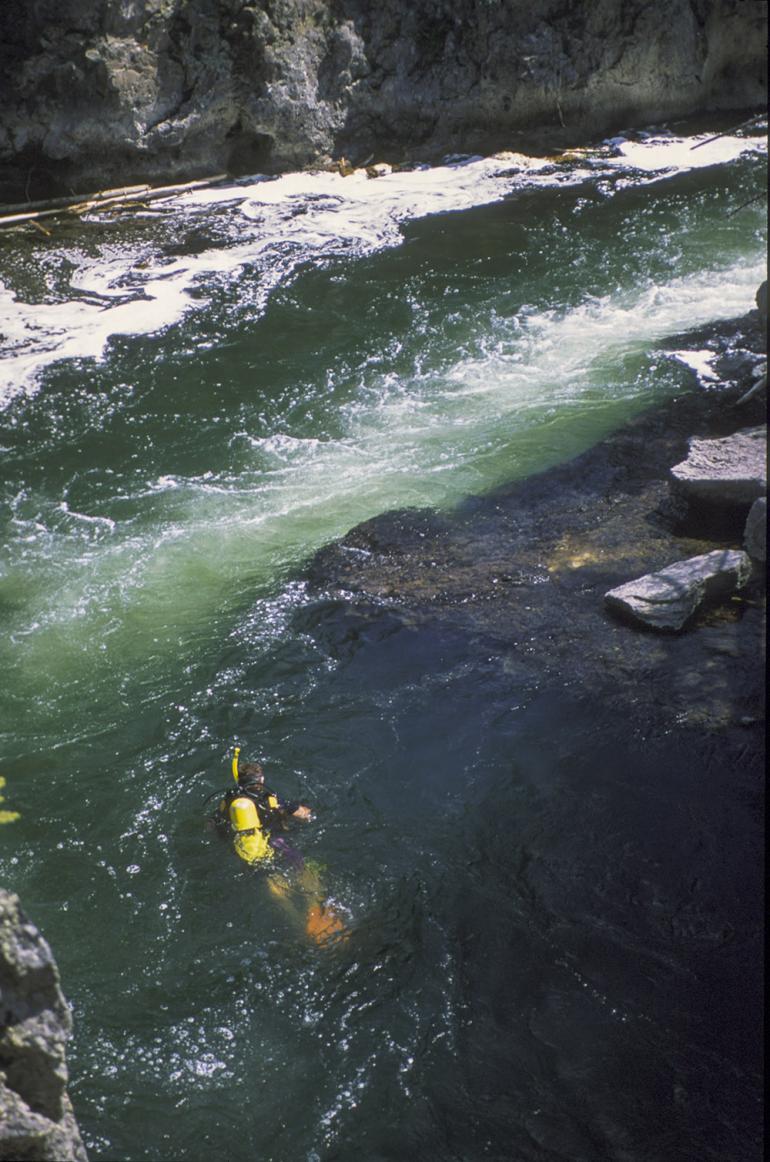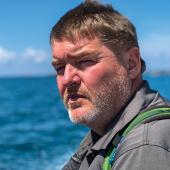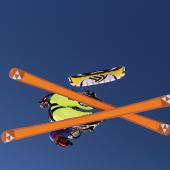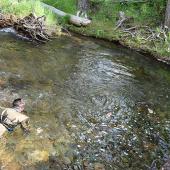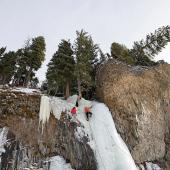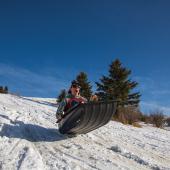The Washing Machine
Scuba diving the Firehole.
On any hot summer day when I was a teenager, all it took was a phone call:
"Hello?"
"Firehole."
Click.
Within the hour, 15 or 20 of us would be on the road to Yellowstone Park. Our caravan of cars and trucks would wind through Gallatin Canyon toward the Firehole River Swimming Area—a 200-yard section of the river heated by deep geothermal something-or-others that keep the water at a comfortable 70 degrees. The lower part is slow-moving and shallow, but the upper stretch snakes swiftly through a deep slot canyon with high cliffs on both sides. The water, though warm, is turbulent and fast at the upper section. I remember the electric fear of a 16-year-old, standing at the top of a 50-foot cliff with all your friends watching and cheering you on. There was no way you couldn't jump. A deep breath and big leap outward, the rushing of gravity, then you're swallowed by the Firehole's warm, rushing waters.
No one ever touched bottom and some said it was a hundred feet deep. Often, we'd just jump into the roiling waves at the very entrance of the constriction, shooting down and through the little s-curve canyon. You could feel the turbulent hydraulics deep below the surface. We always wondered just how deep and wild it must be down there, and what rough, uncharted currents were swirling about.
So it didn't shock me when, 15 years later, a friend called and said, "Firehole." And though cases of beer and car-top surfing seemed unlikely now, it would still be a nice way to relax on a Sunday afternoon. We could swim around, lay in the sun, and maybe even jump off the smaller cliffs if no wardens were around.
But what he meant was to scuba dive the Firehole. Now, I've been diving in some pretty dumb places: inside a longline net in the Gulf of Thailand, in a busy harbor watching ships pass overhead, and through the crashing breakers of the Pacific Ocean on a stormy day. But this just didn't sound like a good idea. I knew all too well the gnarled and volatile waters of the Firehole. And while I wasn't particularly afraid of dying, no one wants to leave a Darwin Award nomination as their legacy. Plus, most diving is pretty static—there are currents, but not like a rushing river through a slot canyon. No way was I diving there, in that wild stretch of water known by locals as "the washing machine."
Two hours later, we strapped on our air tanks on a shelf about midway down the little slot canyon of the Firehole river. I took a last look at the tourists staring at us, calling us fools with their looks. "You ready?" my buddy said. I took a deep breath and slipped into the swirling green water.
At first, I held on rigidly to the rocks lining the side of the gorge with my vest fully inflated—a ship anchor couldn't sink me. This wasn't so bad, I thought. The water seemed wilder than I remembered, and I sensed something ominous was going on below; but I felt fine here, clutching the rock, bobbing on the surface. I started slowly deflating my vest and easing down the cliff face. The water was pushing and pulling me about. I could see nothing but green. Comfortable, but mildly hyperventilating, I stopped a few feet below the surface and practiced emergency procedures—like finding the air hose if it gets ripped out of your mouth—then resurfaced.
I found my buddy and we swam upstream along the cliff wall, out of the current, to the top of the crashing waves. We were at the head of the canyon; below us the water swirled and eddied through the narrow gorge. "Here we go," he said. Ah, what the hell. We grabbed our vent tubes and raised them above our heads, letting the air out of our buoyancy vests. We descended into the deep, churning river, pushing out into the swift current, now about 10 feet under and skimming the bottom. It was light, and fairly clear, so we clutched rocks on the streambed to stop and look around. Small trout darted in and out of the flurry of bubbles. The canyon walls loomed dark up ahead but were light and pocketed to our sides. We eased down the river further and deeper—about 20 feet now. The current grew stronger, more turbulent. Clutching a large rock on the bottom to stay our momentum, we'd get flipped, in slow motion, then tossed back over. It was all we could do to hold on. The sound of water surging and rushing was loudest here. We were in the middle of the washing machine.
From here, we could see where the river had carved deep into the rock over eons. It ran straight into a wall and had begun to undercut and swirl around it. Looking downstream, we spied a dark spot on the floor a few yards away. It was an opening to a cave that went straight down. We looked at each other, nodded, and got out the flashlight. My buddy went first, his body pointed straight down as his feet disappeared down the hole and darkness crept in. I followed the stray light, feeling for the wall and breathing fast. The water became colder and still tossed us back and forth. We kept going down into the cavern, which opened up greatly at the other end and became lighter. At 40 feet, we found the bottom and began exploring the heavily pocketed cavern walls.
It wasn't hard to figure out how the caverns and pockets came to be. In each one, little pebbles were swirling around and around, carving out a larger hole. Some holes we could barely poke our heads in. In the larger ones, we could squeeze our whole bodies through. Sometimes, we'd run into a dark wall and have to backtrack. Most were shallow caves with a soft, gray-green glow and a swirling current. I was getting low on air now and still taking rapid, anxious breaths. But slowly we became accustomed to the rocking motion of the water; the longer we were in, the less we noticed it.
There was the steady sound of rushing water in my ears, my breathing was calming, and I just sat on the bottom looking up at the light through a green lens. We watched trout move in and out of the fast water. Occasionally, a big splash would puncture the top of the water high above us with an explosion of bubbles and squirming white legs. While the trout barely noticed, I knew those bubbles meant the thrill of the jump was over, but the fear of the swirling waters below was just beginning. A fear for me that both started and ended with a word through the phone, "Firehole."
If you want to learn more about scuba diving in the Bozeman area, or want to get certified for future vacations to more popular diving locales, call or stop by the Sports Cove. They've got a full retail shop for scuba and snorkeling gear, and all the latest conditions for diving in Hyalite Reservoir, Canyon Ferry Lake, and the Firehole river, among others. They also host group dives —so come on out and join the crew for treasure hunts, skills practice, and a post-dive BBQ. The Sports Cove offers a range of diving courses, from beginner's classes to instructor certifications. Class are scheduled year-round; call Sarah or Jeff at 585-9926 for more information.

